| Article ID | Journal | Published Year | Pages | File Type |
|---|---|---|---|---|
| 3367635 | Journal of Autoimmunity | 2016 | 6 Pages |
•Plasmapheresis plus immunosuppressive drugs lead to one-year survival ∼87% in patients with Goodpasture syndrome.•1-year overall survival is predicted by age, number of plasma exchanges, and the use of alternative immunosuppressive drugs.•One-year renal survival is only predicted by serum creatinine <500 μmol/L at presentation.•Prospective studies addressing the best regimen of immunosuppressive therapy to add to plasmapheresis are warranted.
The overall and renal outcomes of patients with Goodpasture syndrome (GS), a rare autoimmune disorder characterized by circulating anti-GBM antibodies and rapidly progressive glomerulonephritis and/or pulmonary hemorrhage, have mostly been reported in small-sized cohorts or by aggregating patients receiving a variety of therapies that include aggressive (i.e., combined plasma exchanges, corticosteroids, and cyclophosphamide) and less aggressive (i.e., either plasma exchanges or immunosuppressive drugs, or no treatment). To address the prognosis of GS patients with relatively homogeneous management including plasma exchanges, we conducted a multicenter retrospective study on GS patients included in the registry of the French Society of Hemapheresis. 122 patients were included (kidney alone (n = 28), lung alone (n = 5), or combined involvement (n = 89)). All 122 patients received plasma exchanges (median number of sessions: 13 [9–17]), either alone (n = 8) or associated with combined corticosteroids and oral or IV cyclophosphamide (n = 101) or with corticosteroids alone (n = 12) or cyclophosphamide alone (n = 2). One-year survival was 86.9%. 7/16 patients died from severe infection. In multivariate analyses (Cox’s regression model), being aged <60 years, and number of plasma exchanges were correlated to overall survival. The use of alternative immunosuppressive drugs (because of refractory or relapsing GS) was correlated to mortality at one year. Superiority of oral cyclophosphamide compared to intravenous intake was close to significant. Using a logistic regression model, renal survival in patients alive at 1 year was only predicted by serum creatinine <500 μmol/L at presentation. This large series describes the predictive factors for overall and renal survival of GS patients treated by plasma exchanges. Interventional studies that compare oral and intravenous cyclophosphamide, as well as testing new immunosuppressive therapies, are warranted.
